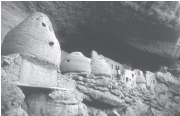| |
In my research, I have found the following sixteen reasons to question the currently accepted view that kivas are strictly religious structures with specific ceremonial uses.
1. The discovery and analysis of the new Sky Island Site with its extensive granary system in the Northern Sierra Madre of Mexico ultimately made it possible to resolve the Anasazi kiva or granary controversy.
2. The large number of “kivas” in Pueblo Bonito have always been suspect.
3. Yellow Jacket has almost two hundred kivas (Lekson, in In Search of Chaco,Ch 4, p25)
4. There are virtually no burials found in round rooms. Burials are never found in food storage areas. Burials are often found in religious structures.
5. There are virtually no artifacts found in round rooms. If round rooms are used for food storage, beer or food preparation, it would be expected that the food remains would have been consumed by humans or rodents so no artifacts would be found
.
6. Hopi kivas are square and below grade.
7. Most Anasazi kivas are round and above grade.
8. The fact that some kivas have been found painted with the stepfret design and covered with soot might be expected from the usage that we are proposing.
9. After C.E. 1275 kivas have been found to be painted with religious murals. This indicates the change to Katsina religious practices.
10. Large kivas have rectangular raised masonry boxes. One of the primary explanations for these boxes is “sprouting vaults.” I believe these vaults were used to sprout corn which is one of the primary steps in making corn beer (the other proposal for the vaults is “foot drums”). While this is certainly possible, the sprouting vaults would be more consistent with the food and beer preparation use, for the large kivas. Due to the sprouting vaults “post wells” and firebox in large kivas, there is actually very little space for ceremonies.
11. Chaco Canyon “over engineering” is demonstrated by the many small kivas that have numerous exterior supporting walls. Archaeologists have described this as over engineering. If the kivas are actually granaries with tons of stored grain then these exterior walls are the proper support for the loose corn exerting outward pressure on the interior walls. This is also evident in virtually all sites where small kivas occur, such as Mesa Verde and the Great Sage Plain/Cayons of the ancients.
12. While all round rooms are being defined as kivas or religious chambers, there are at least three different types and many shapes and sizes in evidence. As far as I can find, there is no “religious” reason given by archaeologists as to the usage of the different types of round rooms. I suggest that each type has a specific use and that the variances within the types have specific practical applications. In fact, I can find no evidence of religious use prior to C.E.1275.
13. Many “small” granaries/kivas and “Great Houses” were built to coincide with the high rainfall period C.E. 1100-1130. There is a significant cluster of construction dates for small kivas during periods of high rainfall or just at the end of high rainfall periods. It is likely that during periods of high rainfall, more grain storage space was needed and this led to a construction boom of Great Houses with “blocked in kivas” which I propose are the supporting structures for the huge silos across the San Juan basin.
14. Yellow Jacket had 192 small kivas. Sand Canyon had over 100 kivas and 14 drying towers. At Sand Canyon the ratio is almost 4:1 rectangular to round rooms.
15. Great Sage Plain (in southwestern Colorado near present day Dove Creek/Cortez) archaeologists strongly feel that kivas were used as living rooms “because of what we find in them” (Varien). I have no doubt that this is true for the time period of the abandonment C.E. 1280 (Kuckelman). Evidence indicates that at the abandonment, the stored corn surplus was long gone and as the most strongly constructed, most secure rooms in the pueblos, round rooms certainly were used as habitations and safe houses. The period of the abandonment demonstrates increased warfare as resources became critically depleted. Families that normally lived in fringe communities moved into the central and strongest pueblos of their relatives for protection, making living space a premium resource. With the silos empty and large population numbers living in centralized pueblos, without adequate food, the people left their most valued, non transportable household items sitting on the floor of the round rooms when they left. This proposal is consistent with accepted archaeological facts and equally it is good common sense, which is often missing when evaluating the vast number of round rooms as “religious kivas.”
16. Without “ethnographic reports” there is no evidence at all to support the religious use of kivas prior to C.E. 1275, rather, I believe, there is extensive circumstantial evidence that these round rooms are corn silos, as might be expected to be found in a culture whose entire purpose and focus was on growing corn.
|
|





